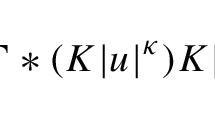Abstract
This paper deals with the shape dependence of the dielectric susceptibility (equivalently defined, in a canonical ensemble, by the mean square fluctuation of the electric polarization or by the second moment of the charge-charge correlation function) of classical Coulomb systems. The concept of partial second moment is introduced with the aim of analyzing the contributions to the total susceptibility of pairs of particles of increasing separation. For a diskshaped one-component plasma with coupling parameter γ=2 it is shown, numerically and algebraically for small and large systems, that (1) the correlation function of two particles close to the edge of the disk decays as the inverse of the square of their distance, and (2) the susceptibility is made up of a bulk contribution, which saturates rapidly toward the Stillinger-Lovett value, and of a surface contribution, which varies on the scale of the disk diameter and is described by a new law called the “arc sine” law. It is also shown that electrostatics and statistical mechanics with shape-dependent thermodynamic limits are consistent for the same model in a strip geometry, whereas the Stillinger-Lovett sum rule is verified for a boundary-free geometry such as the surface of a sphere. Some results of extensive computer simulations of one- and two-component plasmas in circular and elliptic geometries are shown. Anisotropy effects on the susceptibilities are clearly demonstrated and the “arc sine” law for a circular plasma is well confirmed.
Similar content being viewed by others
References
C. Kittel,Introduction to Solid State Physics, 4th ed. (Wiley, New York, 1971), Chapter 13.
J. D. Jackson,Classical Electrodynamics, 2nd ed. (Wiley, New York, 1975), Sections 4.3–4.5.
Handbuch der Physik: Dielektrika, Band XVII (Springer-Verlag, 1956), Sections 22–24.
O. F. Mossotti,Memorie di Matematica e di Fisica della Società Italiana delle Scienze residente in Modena XXIV(2):49–74 (1850).
R. Clausius,Die mechanische Wärmetheorie, 2nd ed. (Friedrich Vieweg, Braunschweig, 1879), Vol. 2, pp. 62–97.
R. Becker,Electromagnetic Fields and Interactions (Blaisdell, 1964), pp. 102–107.
S. R. De Groot and L. G. Suttorp,Foundations of Electrodynamics (North-Holland, Amsterdam, 1972), pp. 106–109.
J. A. Osborn,Phys. Rev. 67:351 (1945).
E. C. Stoner,Phil. Mag. 36:803 (1945).
E. R. Smith and P. Wielopolski,J. Phys. A: Math. Gen. 15:2557–2568 (1982).
P. M. Morse and H. Feshbach,Methods of Theoretical Physics, Part 2, (McGraw-Hill, New York, 1953).
P. J. Forrester and E. R. Smith,J. Phys. A: Math. Gen. 15:3861–3868 (1982).
B. Jancovici,J. Stat. Phys. 28:43 (1982).
J. M. Caillol,J. Phys. Lett. 42:L-245–247 (1981).
Ph. Choquard, B. Piller, and R. Rentsch,J. Stat. Phys. 43:197 (1986).
Author information
Authors and Affiliations
Rights and permissions
About this article
Cite this article
Choquard, P., Piller, B. & Rentsch, R. On the dielectric susceptibility of classical Coulomb systems. II. J Stat Phys 46, 599–633 (1987). https://doi.org/10.1007/BF01013377
Received:
Issue Date:
DOI: https://doi.org/10.1007/BF01013377




